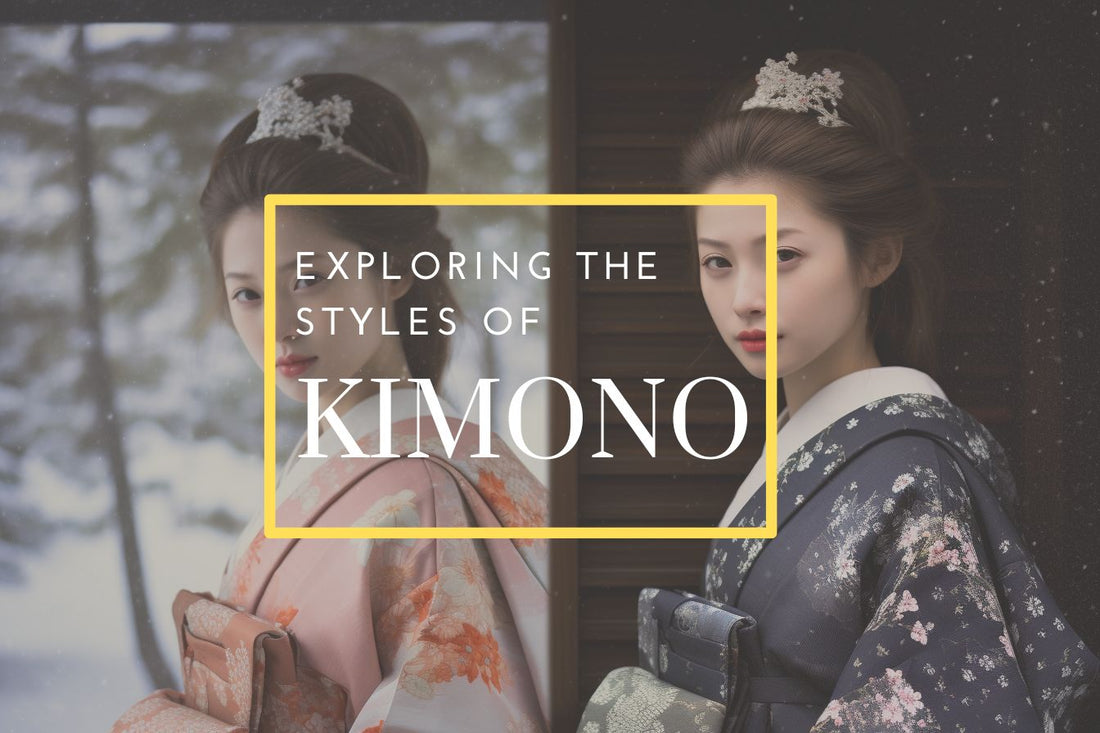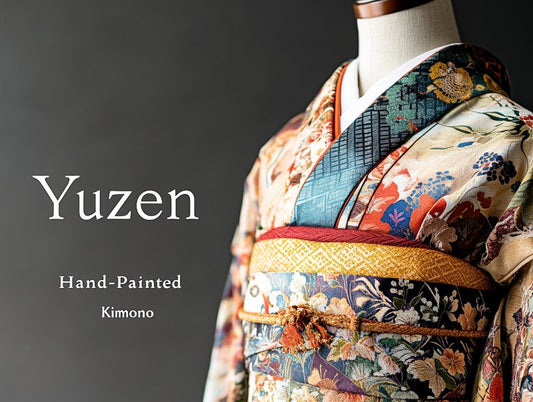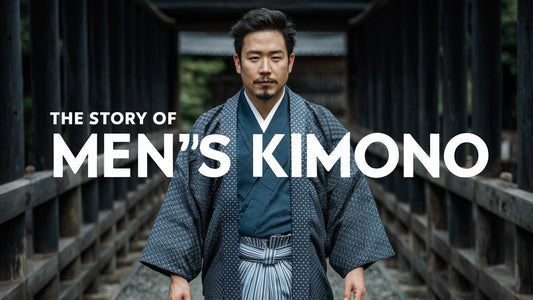
Exploring the Many Styles of Kimono
Share
The kimono is a traditional Japanese garment that holds a significant place in the country's culture and history. With its elegant design, vibrant colors, and intricate patterns, the kimono has become a symbol of Japan's rich heritage. In this article, we will delve into the world of kimono, exploring its various styles, fabrics, and occasions it is worn for.
Introduction
The kimono, which translates to "thing to wear" in Japanese, has a long history dating back centuries. It is a T-shaped, ankle-length robe with wide sleeves and a wrap-around style. Traditionally, kimonos were worn by both men and women in Japan, but over time, their use became more prevalent among women.
The kimono holds immense cultural significance in Japan. It represents not only the country's traditions and values but also serves as a form of self-expression and art. Kimonos are often worn during special occasions such as weddings, tea ceremonies, and festivals, highlighting the importance of this garment in Japanese culture.
Traditional Kimono Styles
Furisode
In our exploration of the intricate world of Japanese kimonos, there are distinct styles and designs that carry rich cultural narratives. The furisode, for instance, is a captivating style primarily worn by young, unmarried women. Characterized by its long, flowing sleeves and radiant colors, it is a visual representation of youth and elegance. Each kimono, like the furisode, has its own tale steeped in tradition and symbolism. For those wishing to delve further into the captivating intricacies of the furisode, a comprehensive breakdown is available on Kimonokoi.

Tomesode
The tomesode is a quintessential formal kimono for married women, originating from Japan's Edo period. Characterized by its unique patterns located below the waist, this kimono has two types: the black Kuro-tomesode and the colorful Iro-tomesode. Primarily worn at weddings by relatives of the bride or groom and other significant family ceremonies, the tomesode stands as a testament to Japanese tradition, reflecting marital status, familial ties, and aesthetic reverence in its intricate designs. As it finds its place in modern fashion, the tomesode remains a symbol of elegance and heritage in Japanese attire.
-The tomesode is an elegant kimono worn by married women during formal events.
-It typically has a pattern that covers only the lower part of the garment.
Read more about the Tomesode here

Houmongi
-The houmongi is a semi-formal kimono suitable for various occasions.
- It often features a continuous pattern that extends across the seams.

Iromuji
-The iromuji is a single-color kimono that can be worn by both married and unmarried women.
- It is often worn during tea ceremonies and other formal gatherings.

Komon
- The komon is a casual kimono featuring small, repeated patterns.
- It is suitable for everyday wear and less formal occasions.

Regional Variations
You'll find in some instances that similar terms can be used for the same or similar kimono. Here are a few examples of more specific terms for very specific kimono.
-
Kurotomesode
- The kurotomesode is a black kimono adorned with elegant designs.
- It is often worn by married women during formal events.
-
Uchikake
- The uchikake is a heavily embroidered, outer kimono used in wedding ceremonies.
- It is characterized by its vibrant colors and elaborate patterns.
-
Shiromuku
- The shiromuku is a pure white kimono worn by brides during traditional weddings.
- It symbolizes purity and the beginning of a new chapter in life.
-
Tsumugi
- The tsumugi is a kimono made from silk spun by hand.
- It has a textured appearance and is popular in certain regions of Japan.
-
Yukata
- The yukata is a casual, lightweight kimono often worn during summer festivals.
- It is made of cotton and features colorful patterns.
Contemporary Kimono Styles
In recent years, the kimono has undergone modern adaptations to cater to changing fashion trends. Designers have incorporated Western influences into kimono fashion, resulting in innovative and contemporary styles.

Kimonos with shorter lengths, vibrant prints, and unconventional materials have become popular among the younger generation, allowing them to embrace their cultural heritage in a more fashion-forward way.
Kimono Fabric and Patterns

-
Silk
- Silk is the most traditional and coveted fabric used in kimono production.
- It offers a luxurious feel and a stunning drape, making it ideal for formal occasions.
-
Cotton
- Cotton is a comfortable and breathable fabric used in casual kimonos like yukatas.
- It is especially popular during the summer months and at festivals.
-
Synthetic Fabrics
- In recent years, synthetic fabrics such as polyester have been used to create affordable and easy-to-care-for kimono options.
-
Traditional Patterns
- Kimono patterns often feature symbolic motifs such as cherry blossoms, cranes, or waves.
- These patterns hold cultural significance and add depth to the overall design of the kimono.
Kimono for Special Occasions

- Spring is a season that celebrates the beauty of nature and new beginnings.
- Spring kimonos often feature delicate floral patterns, reflecting the blooming cherry blossoms.

- Matsuri, meaning festival, is a time when vibrant colors and lively celebrations fill the streets.
- Matsuri kimonos are often bold and feature dynamic patterns, adding to the festive atmosphere.
How to Wear a Kimono
Wearing a kimono is not merely putting on a garment but a meticulous art form that requires skill and precision. Each component must be carefully adjusted and tied to achieve the desired aesthetic and maintain cultural authenticity. Understanding the layers and components of a kimono, as well as the associated dressing techniques and etiquette, is essential to fully appreciate and embrace this traditional attire.
Layers and Components of a Kimono
Undergarments- Before donning the kimono, one must wear specific undergarments known as hadajuban or nagajuban.
- The hadajuban is a white, full-length kimono-like garment worn closest to the skin, providing a base for the layers to come.

- Over the hadajuban, the nagajuban is worn. It is typically more decorative and visible in certain areas, such as the collar and sleeves.
 Kimono
Kimono
- The kimono itself is the main garment. It is a T-shaped robe with wide, flowing sleeves and a wrap-around style.
- Kimonos come in various styles, lengths, and patterns, each suitable for different occasions and seasons.
- The choice of kimono depends on factors such as age, marital status, and the formality of the event.
- The obi is a wide sash that wraps around the waist, securing the kimono in place and adding a decorative element.
- Obis are available in different materials, colors, and patterns, and their tying styles vary depending on the occasion and the wearer's proficiency.

- The width and design of the obi can significantly impact the overall look of the kimono.
- Accessories play a vital role in completing the kimono ensemble.
- Tabi, traditional split-toe socks, are worn with zori or geta, Japanese sandals. While at first glance these socks look like normal socks with a split toe section, the higher quality tabi socks will include fasteners and some type of grip on the bottom so your feet don't slip in your geta or zori.
- A decorative cord called an obijime is often tied around the obi, adding a pop of color and accentuating the waistline.
- Other accessories may include kanzashi (hair ornaments) and small purses or bags.
Dressing Techniques and Etiquette
-
Putting on the Kimono
- Start by wearing the undergarments, ensuring they are properly adjusted and securely fastened.
- Next, layer the kimono over the undergarments, ensuring the collar is even and the length is appropriate.
- Cross the right side of the kimono over the left and wrap it snugly around the body.
-
Tying the Obi
- Tying the obi requires skill and practice. There are various tying styles, each suitable for different occasions and kimono styles.
- The most common obi tying method is called otaiko, which involves folding the obi into a decorative knot at the back.
- The obi should be tied tightly but comfortably, accentuating the waistline and creating an elegant silhouette.
-
Etiquette
- Wearing a kimono comes with specific rules and etiquette that vary depending on the occasion and formality.
- When wearing a kimono, it is customary to walk with small, shuffling steps and maintain good posture.
- There are specific ways of sitting, standing, and even holding the sleeves of the kimono to display proper respect and grace.
Mastering the art of wearing a kimono takes time, patience, and guidance. Attending workshops, seeking advice from experts, or learning from experienced individuals within the community can greatly enhance one's understanding and ability to wear a kimono correctly. Adhering to the traditional dressing techniques and etiquette ensures the cultural authenticity and appreciation of this iconic Japanese attire.
Kimono Accessories
-
Obi
- The obi is a wide sash that wraps around the waist, securing the kimono in place.
- It plays a crucial role in defining the overall look of the kimono.
-
Geta and Zori
- Geta and zori are traditional Japanese footwear worn with kimonos.
- Geta are wooden sandals with elevated platforms, while zori are flat sandals.
-
Kanzashi (Hair Ornaments)
- Kanzashi are decorative hair ornaments often worn with kimonos.
- They come in various shapes and designs, adding a touch of elegance to the hairstyle.
Kimono in Popular Culture
-
Influence in Movies and TV Shows
- Kimonos have made appearances in numerous films and television shows, both in Japan and internationally.
- They contribute to the visual storytelling and help portray characters' cultural identity.
-
Kimono-Inspired Fashion Trends
- Kimono-inspired elements have influenced fashion trends worldwide.
- Designers incorporate kimono-inspired silhouettes, prints, and fabrics into their collections.
Conclusion
The kimono is a timeless symbol of Japanese culture, elegance, and artistry. Its diverse styles, fabrics, and patterns showcase the rich traditions and creativity of the Japanese people. Whether worn for special occasions or as a fashion statement, the kimono continues to captivate and inspire people around the world.
You may want to read about the art of crafting kimonos here!
FAQs
-
What is the difference between a yukata and a kimono?
- While both are traditional Japanese garments, yukatas are made of cotton and are more casual, often worn during summer festivals, whereas kimonos are more formal and made of silk or other luxurious materials.
-
Can men wear kimonos?
- Yes, men can wear kimonos. However, their styles and patterns differ from those worn by women.
-
How long does it take to put on a kimono?
- Putting on a kimono requires skill and practice. It can take anywhere from 30 minutes to over an hour, depending on the complexity of the style and the individual's experience.
-
Are kimono patterns symbolic?
- Yes, many kimono patterns have symbolic meanings. They often represent nature, good luck, or cultural motifs that hold significance in Japanese society.
-
Where can I buy an authentic kimono?
- Authentic kimonos can be purchased from specialty kimono stores, vintage shops, or online marketplaces that specialize in traditional Japanese attire.


